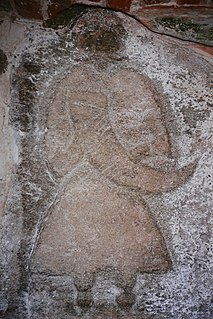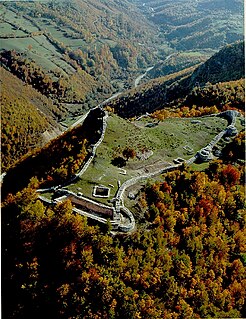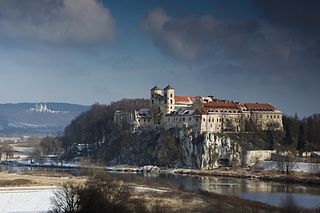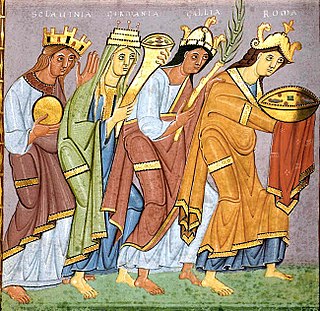
Cyril and Methodius (815–885) were two brothers and Byzantine Christian theologians and missionaries. For their work evangelizing the Slavs, they are known as the "Apostles to the Slavs".

Slavs are Indo-European people who speak the various Slavic languages of the larger Balto-Slavic linguistic group. They are native to Eurasia, stretching from Central, Eastern, and Southeastern Europe all the way north and eastwards to Northeast Europe, Northern Asia (Siberia), and Central Asia, as well as historically in Western Europe and Western Asia. From the early 6th century they spread to inhabit most of Central, Eastern and Southeastern Europe. Today, there is a large Slavic diaspora throughout North America, particularly in the United States and Canada as a result of immigration.

Old Church Slavonic or Old Slavonic, also known as Old Church Slavic, or Old Slavic, was the first Slavic literary language. It is also referred to as Paleo-Slavic (Paleoslavic) or Palaeo-Slavic (Palaeoslavic), not to be confused with Proto-Slavic. It is often abbreviated to OCS.
Gospel music is a genre of Christian music. The creation, performance, significance, and even the definition of gospel music varies according to culture and social context. Gospel music is composed and performed for many purposes, including aesthetic pleasure, religious or ceremonial purposes, and as an entertainment product for the marketplace. Gospel music usually has dominant vocals with Christian lyrics. Gospel music can be traced to the early 17th century, with roots in the black oral tradition. Hymns and sacred songs were often repeated in a call and response fashion. Most of the churches relied on hand clapping and foot stomping as rhythmic accompaniment. Most of the singing was done a cappella. The first published use of the term "gospel song" probably appeared in 1874. The original gospel songs were written and composed by authors such as George F. Root, Philip Bliss, Charles H. Gabriel, William Howard Doane, and Fanny Crosby. Gospel music publishing houses emerged. The advent of radio in the 1920s greatly increased the audience for gospel music. Following World War II, gospel music moved into major auditoriums, and gospel music concerts became quite elaborate.

Slavic paganism or Slavic religion describes the religious beliefs, myths and ritual practices of the Slavs before the formal Christianisation of their ruling elites. The latter occurred at various stages between the 8th and the 13th century: The South Slavs living on the Balkan Peninsula in South Eastern Europe, bordering with the Byzantine Empire to the south, came under the sphere of influence of Eastern Orthodox Christianity, beginning with the creation of the Slavic alphabet in 855 by the brothers Saints Cyril and Methodius and the adoption of Christianity in Bulgaria in 863 AD. The East Slavs followed with the official adoption in 988 AD by Vladimir the Great of Kievan Rus'.

The Early Cyrillic alphabet is a writing system that was developed in the First Bulgarian Empire during the late 9th century on the basis of the Greek alphabet for the Slavic peoples living near the Byzantine Empire in South East and Central Europe. The objective was to make it possible to have Christian service in Slavic tongue, instead of in Greek, which locals did not understand, and to bring Bulgarian subjects closer to the cultural influence of Christianity, the official religion of the Byzantine Empire. It was used by Slavic peoples in South East, Central and Eastern Europe.

The Northern March or North March was created out of the division of the vast Marca Geronis in 965. It initially comprised the northern third of the Marca and was part of the territorial organisation of areas conquered from the Wends. A Lutician rebellion in 983 reversed German control over the region until the establishment of the March of Brandenburg by Albert the Bear in the 12th century.

A lectionary is a book or listing that contains a collection of scripture readings appointed for Christian or Judaic worship on a given day or occasion. There are sub-types such as a "gospel lectionary" or evangeliary, and an epistolary with the readings from the New Testament Epistles.

The Pontifical Croatian College of St. Jerome is a Catholic college, church and a society in the city of Rome intended for the schooling of South Slav clerics. It is named after Saint Jerome. Since the founding of the modern college in 1901, it has schooled 311 clerics from all bishoprics of Croatia.

Ras, known in modern Serbian historiography as Stari Ras, is a medieval fortress located in the vicinity of former market-place of Staro Trgovište, some 11 km west of modern day city of Novi Pazar in Serbia.

Tyniec is a historic village in Poland on the Vistula river, since 1973 a part of the city of Kraków. Tyniec is notable for its famous Benedictine abbey founded by King Casimir the Restorer in 1044. The name of the village comes from a Celtic language word "tyn", which means wall or fence, and which means that the history of Tyniec as a fortified settlement dates back to pre-Slavic times.

In the medieval history of Europe, Bulgaria's status as the Bulgarian Empire, wherein it acted as a key regional power occurred in two distinct periods: between the seventh and eleventh centuries, and again between the twelfth and fourteenth centuries. The two "Bulgarian Empires" are not treated as separate entities, but rather as one state restored after a period of Byzantine rule over its territory.

The Christianization of Bulgaria was the process by which 9th-century medieval Bulgaria converted to Christianity. It reflected the need of unity within the religiously divided Bulgarian state as well as the need for equal acceptance on the international stage in Christian Europe. This process was characterized by the shifting political alliances of Boris I of Bulgaria with the kingdom of the East Franks and with the Byzantine Empire, as well as his diplomatic correspondence with the Pope.

The Sclaveni or Sklavenoi were early Slavic tribes that raided, invaded and settled the Balkans in the Early Middle Ages and eventually became known as the ethnogenesis of the South Slavs. They were mentioned by early Byzantine chroniclers as barbarians having appeared at the Byzantine borders along with the Antes, another Slavic group. The Sclaveni were differentiated from the Antes and Wends ; however, they were described as kin. Eventually, most South Slavic tribes accepted Byzantine suzerainty, and came under Byzantine cultural influence. The term was widely used as general catch-all term until the emergence of separate tribal names by the 10th century.

Moravský Krumlov is a town in the Znojmo District, South Moravian Region, Czech Republic. It has about 6,023 inhabitants.

Radoslav's Gospel was created in 1429 by miniaturist Radoslav, and Celibate Priest Feodor, a Serbian monk-scribe from Dalša. It contains a number of miniatures, including "An Evangelist Portrait". The gospels are in the Russian National Library, St. Petersburg. In 2001 it was republished by the National Library of Serbia and the Central Bank of Yugoslavia as part of the Svetilnik series.

In Christian theology and ecclesiology, apostles, particularly the Twelve Apostles, were the primary disciples of Jesus according to the New Testament. In addition to Christian theology, Islamic theology also acknowledges the apostles in the Qur’an. During the life and ministry of Jesus in the 1st century AD, the apostles were his closest followers and became the primary teachers of the gospel message of Jesus.
This is a list of people, places, and events related to the medieval Bulgarian Empires — the First Bulgarian Empire (681–1018), and the Second Bulgarian Empire (1185–1396).
The national symbols of Bulgaria are the symbols that represent Bulgaria and the Bulgarian people.

The Slavs were Christianized in waves from the 7th to 12th century, though the process of replacing old Slavic religious practices began as early as the 6th century. Generally speaking, the monarchs of the South Slavs adopted Christianity in the 9th century, the East Slavs in the 10th, and the West Slavs between the 9th and 12th century. Saints Cyril and Methodius are attributed as "Apostles to the Slavs", having introduced the Byzantine-Slavic rite and Glagolitic alphabet, the oldest known Slavic alphabet and basis for the Early Cyrillic alphabet.


















